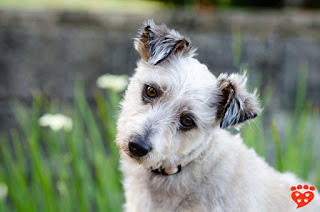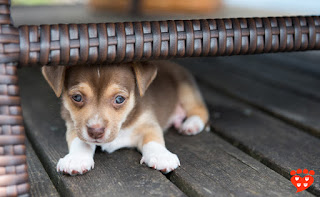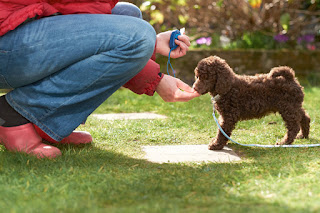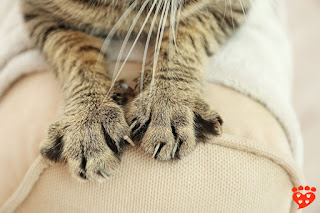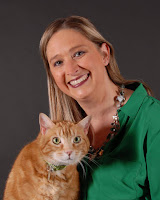Cat experts – including Mikel Delgado, Pam Johnson-Bennett, Sandra McCune, Kersti Seksel and Nicky Trevorrow – weigh in on the one thing that would make the world better for cats.
 |
| Photo: JRJfin |
We love our feline friends, but at the same time there’s a lot that we, as a society, could do to make cats happier. So I asked several experts on cats to answer the question, “What’s the one thing that would make the world better for cats?”
Read on to see what they have to say. And if you're a dog person, there's a related post on
how to make the world better for dogs to check out next.
This post is
also available in Japanese. Thank you to Saramu Momma MSc and Risa Yoshida for the translation.
Sebastiaan Bol, PhD
Founder and CEO of Cowboy Cat Ranch (Website
http://www.cowboycatranch.org/ Twitter,
Facebook)
"Cats love plants (but only the ones that are safe for them)"
“In general, creating a safe, fun and challenging environment for cats will make them truly happy. Environmental enrichment such as a catio, cat trees, shelves on the wall, hiding places and food puzzles really make a huge difference for a cat's well-being. But you asked me to name one thing that would make the world better for cats, I am sorry. Plants. Cats love plants (but
only the ones that are safe for them). Not only do they really like to eat the grass from oat, rye, wheat and barley seeds, they also love to lie on or in the grass. Seeding your own grass is easy to do and will give much nicer grass compared to when you buy cat grass in the store. Other plants that deserve a place in each house with a cat are living catnip plants, silver vine and Tatarian honeysuckle. Or, to be more specific, wood sticks or powder from the fruit of the silver vine plant, and the wood of Tatarian honeysuckle. They are like catnip, but just a little different. These plants contain chemicals not present in catnip, allowing cats who do not enjoy catnip to have a good time too. Cats who do enjoy catnip may of course still love silver vine and Tatarian honeysuckle as well. The big pieces of honeysuckle wood (stem or branch) look beautiful and will last a lifetime. So, make a difference for your cat today and invest in a huge piece of
Tatarian honeysuckle wood, sprinkle some silver vine powder on the carpet, and grow some super fresh
cat grass! They'll love you even more!"
Mikel Delgado, PhD
Postdoctoral Fellow at the School of Veterinary Medicine, UC Davis and Certified Cat Behavior Consultant at
Feline Minds (
Twitter)
"if everyone who lived with a cat played with them daily, with interactive toys"
“I usually answer a question like this with “If everyone recognized that cats are not dogs or humans.” But this time, I’d rather say, the world would be a better place for cats if everyone who lived with a cat played with them daily, with interactive toys (e.g. a cat dancer). Many of my behavior consulting clients tell me their cats don’t or won’t play. But cats are obligate predators, and they all (even seniors and cats with disabilities!) have the capacity for interactive play that mimics the hunting experience! I take great pleasure in showing clients how to get their cats stalking, pouncing, or even just mentally engaged with an interactive toy. I think many people don’t play with purpose, and get frustrated when their cat doesn’t respond enthusiastically to a randomly waving feather. But if you move the toy like a prey animal would move, and use all your cat’s senses, and remember they are a “stalk-and- rush” hunter, you will have GREAT SUCCESS (to quote Borat)! So many housecats are leading under-stimulated lives. We give them love, but that isn’t enough. They need the benefits of physical exercise (both for staying fit and for reducing stress), and playing with your cat a few minutes a day with a wand toy is a fun bonding experience for you both!”
Lauren Finka, PhD
Postdoctoral Research Fellow at the University of Lincoln (
Twitter)
“an appreciation of the evolutionary history of the domestic cat, and how important this is for a better understanding of this species"
“It would be great for owners and those caring for cats to have an appreciation of the evolutionary history of the domestic cat, and how important this is for a better understanding of this species and their biological and psychological needs today. Many of these needs are still similar to those of their closest ancestors, the North African/Arabian wildcat; a self-reliant predator which is territorial, spends a large proportion of each day exploring and hunting, and values solitude and the ability to escape from threats by hiding or getting up high. However, we now expect the domestic cat to live in a world very different from that of its relatives – often restricting their ability to explore and hunt within a complex environment (i.e. by confining them indoors), expecting them to live a much more social lifestyle (i.e. with other cats and with us), and to tolerate a lot of physical handling (i.e. we love to cuddle and fuss over cats). Whilst many cats are able to cope well and live up to our expectations, many may also struggle, either due to a lack of suitable socialisation during their early development (i.e. 2-7 weeks) and beyond, other aspects of their temperament, or simply a lack of opportunity to behave as they are biologically motivated to. How we can help is by choosing cats that we think will be able to enjoy the type of lifestyle we have, supplying them with many opportunities for positive cognitive and sensory stimulation, the ability to escape from things they find stressful, and also being careful about how much ‘social pressure’ we are exerting upon them; providing them with many opportunities to have time alone undisturbed.”

Sam Gaines, PhD
Head, Companion Animals Department,
RSPCA (Sam's
Twitter; RSPCA on
Twitter,
Facebook,
Instagram)
"more realistic expectations around the interactions which cats appreciate: frequent but short."
“Sadly the social behaviour of cats, and especially their interactions with people, is very misunderstood. Most cats typically want high frequency but lower intensity interactions whereas many people want fewer interactions but for a longer period of time. This mismatch can lead to defensive aggression in cats with some being labelled as grumpy or spiteful. Having more realistic expectations around the interactions which cats appreciate; frequent but short, will avoid unnecessary stress, fear and worry and will help strengthen the bond between cat and owner.”
Naomi Harvey, PhD
Research Fellow, Itchy Dog Project, School of Veterinary Sciences, University of Nottingham (
Twitter)
"That people accept them as individuals, with rich personalities and complex social needs."
“That people accept them as individuals, with rich personalities and complex social needs. People who haven’t had a close relationship with a cat often assume the stereotype that cats are ‘independent’ and just ‘use’ people for food and warmth. This leads some people to consider cats as an option for a pet that requires less attention and responsibility than a dog. However, as I’m sure cat lovers will be happy to tell you, cat personalities differ greatly, as do their social needs. Many cats are capable of great affection, and if given a choice would choose to be in your company rather than alone, which can mean their welfare is easily compromised when left alone for long periods or are shut outside all day.”
Ingrid Johnson, CCBC
Certified Cat Behavior Consultant at
Fundamentally Feline (
Twitter,
Facebook,
Instagram)
“a better understanding of a cat’s environmental necessities."
“I think the single most important improvement in the care and welfare of cats is quite simply, a better understanding of a cat’s environmental necessities. This greater grasp needs to be industry-wide. There is a distinct disconnect between what cats need and what is being offered to feline caregivers to help meet those needs. A clearer understanding of a cat’s physical and emotional needs must be improved across the board from veterinary professionals to pet product designers and cat guardians alike. Forcing cats to comply with our human world and expectations sets them up to fail. Less environmental stress leads to less physical illness and fewer behavior problems. There is a recent trend to change the term “environmental enrichment” to a more fitting “environmental needs” and I embrace that trend. Many “behavior problems” would never become problems at all if cats were simply provided with an environment that embraces their inner “catness”. They need bigger litter boxes (and more of them). They need taller and more abrasive scratching posts, not these ridiculous carpet scraps that hang from doorknobs. Cats need to be challenged and offered a stimulating world that evokes their inner predator while simultaneously providing the safety and security they crave. The movement is growing as the public demand for more knowledge and better products increases, but we still have a long way to go towards making our homes more feline friendly.”

Pam Johnson-Bennett
Best-selling author and star of Animal Planet UK's Psycho Kitty. (Website
http://www.catbehaviorassociates.com/,
Twitter,
Facebook)
"if we could finally change the misconceptions people have about them."
“One thing that would make a huge difference in the lives of cats is if we could finally change the misconceptions people have about them. Hatred of cats, punishment, neglect and callous attitudes develop because people believe myths and false information about what drives cat behavior. Cats are often viewed as either sinister bird killers or low maintenance alternatives when you don’t want to put much effort into being a pet parent. Education can open hearts to how wonderful it is to love and be loved by these magnificent animals.”
Kat Littlewood, BVSc(dist) PGDipVCS(dist)
Small animal veterinarian and PhD candidate with
Animal Welfare Aotearoa (AWA) at Massey University. (Website
https://katwelfarematters.wordpress.com/,
Twitter,
Facebook)
"I would like veterinarians and owners to work together to make judgements on quality of life - before it is significantly compromised."
“Sooner rather than later: If owners, and their veterinarians, considered death earlier, then quality of life would be better for cats. Most cat owners tell us, after they have euthanased their beloved cat, that they wish they had done it sooner. It can be really difficult to make the decision at the time – especially if owners are strongly attached to their cat and/or think of them as a member of the family. Owners also adapt to their cat’s declining quality of life and poor welfare becomes the new normal for their pet. However, for the cat’s wellbeing, it is better to start thinking about ‘how it is doing’ sooner rather than later. I would like veterinarians and owners to work together to make judgements on quality of life - before it is significantly compromised. We need to break down the taboo of talking about death. When a cat is diagnosed with an illness, particularly if it’s terminal, its death should be discussed. When a cat reaches a certain age, we need to have ‘that’ conversation. What does a good life look like for this cat? How will we know when it is no longer enjoying life? By having these frank discussions earlier, we can help reduce the ‘wish I had done it sooner’ effect and improve the quality of our cats’ lives.”
Sandra McCune, PhD
Scientific Leader – Human-Animal Interaction, Science Engagement and Communications Team, WALTHAM Centre for Pet Nutrition. (Sandra on
Twitter, Waltham website
www.waltham.com and
Twitter)
“owners understanding better the role food plays in their relationship with their cat."
“One thing that would make a better world for cats is owners understanding better the role food plays in their relationship with their cat. For many owners, food is a currency of love. Offering excess food and especially highly palatable food not intended for cats can harm their health. Helping owners to understand their cat’s need for the appropriate amount of a complete and balanced diet is key to tackling the problem of feline obesity, now an issue for almost 60% of US cats. We need to help cat owners change their behaviour without diminishing their bond. #ABetterWorldForPets”
Kim Monteith, CTC
Manager, Animal Welfare, BC SPCA. (Kim's
Twitter; BC SPCA website:
http://spca.bc.ca/,
Twitter,
Facebook,
Instagram)
"Early socialization will help them not be afraid of new things or changes in their environment"
"If we promote and teach kitten socialization the way we do with puppies the world would be a better place for cats. The socialization window - open from 3 to 7 weeks - is so important for them and what they learn about the world. We need to provide kittens with good experiences during this time. Introduce them to different people, environments, objects, animals and handling. Think of how different their experiences and life would be if we did this. Early socialization will help them not be afraid of new things or changes in their environment which are bound to happen. It's so simple, yet we don't often think of the importance of cat socialization like we do with dogs. Maybe that's it, we need to change the way we think about cats ..."
Kate Mornement, PhD
Pets Behaving Badly – Solutions with Dr. Kate. (Website
http://petsbehavingbadly.com.au/,
Twitter,
Facebook)
"Pet cats, especially those confined to the home, must have appropriate outlets for the expression of normal feline behaviours"
“One thing that would make the world a better place for cats is if cat owners understood that, although domesticated, companion cats retain the instinct and desire to perform normal feline behaviours. These behaviours include scratching and scent marking; seeking, hunting and stalking, and maintaining a secure territory. Until fairly recently, pet cats were free to roam their neighbourhoods at will. This freedom allowed them to maintain a larger territory, to hunt and stalk prey, climb, scratch, problem solve and keep physically fit – in essence, to be a cat. This is no longer the norm in many cities where cat curfews are now enforced. Pet cats, especially those confined to the home, must have appropriate outlets for the expression of these normal feline behaviours - without them problem behaviour, such as destructive scratching of furniture and aggression towards people/other animals in the home, is common. Stress and anxiety, especially common in multi-cat homes where cats compete for access to valued resources, can lead to inappropriate toileting and territorial marking – a common reason for relinquishment to animal shelters. Providing cats with appropriate outlets for normal feline behaviours should include: the provision of scratch posts and cat scratchers; cat towers or high shelving to provide a safe place to retreat to; ready access to several litter trays (especially important in multi-cat households); and safe access to outdoor space if possible. The opportunity for daily play with toys that mimic prey provides an outlet for hunting and stalking behaviour, which can reduce aggression towards people or other animals in the home.”
Kersti Seksel, BVSc (Hons) MRCVS MA (Hons) FANZCVS DACVB DECAWBM FAVA
Veterinary Behaviour Specialist at Sydney Animal Behaviour Service. Website:
http://sabs.com.au/"Education of people about cat behaviour is the biggest key to helping cats around the world"
“Education of people about cat behaviour is the biggest key to helping cats around the world. Knowing how cats “tick” and what they like would be helpful. Teaching this at Kitten Kindy classes is the easiest and most effective way besides being lots of fun for kittens and owners alike. Cats are social animals but that does not mean all cats are socialised. Being socialised means that the individual accepts the close proximity of others – cats and people. It does not mean they have to like all others – sounds like us really doesn’t it? The socialisation period – when it is easiest to help kittens learn about their world – occurs between 3 and 7 weeks of age. So the way the breeder raises the kitten is so important. However, socialisation can occur at any age. So what can make a difference to cats during and after the socialisation period? Many people want cats to have a best friend, but many (most) cats are more suited to being an only cat. Some other behavioural needs of cats that are not widely known include: Cats prefer their food and water to be a good distance apart. The ideal litter tray is 1.5 times the length of the cat, and very few are made this big. Some also have lids and flaps to keep the smell out for the owner. Many cats will cope but they don’t necessarily like them, and those cats may develop toileting problems as a result. So knowing about the cat's behavioural needs and respecting them would really make the world a better place for cats and starting during the socialisation period is best.”
Jenny Stavisky, PhD
Assistant Professor, Shelter Medicine, School of Veterinary Medicine and Science, University of Nottingham (Jenny on
Twitter;
Vets in the Community on
Twitter)
"for us to have a better understanding of how they see the world."
“The one thing that would make the world better for cats I think might be for us to have a better understanding of how they see the world. Unlike us, and unlike dogs, they aren’t naturally gregarious as a species. This means that whilst some cats like some other cats, for the most part (there are always exceptions…) cats don’t want, like or need lots of cat buddies. So when we keep them as pets, one cat in a household is fine, and certainly doesn’t need to have extra friends! Also, cats are nature’s control freaks and need some self-determination. One of the most common problems I see is when people forget that feral cats are truly wild animals and, meaning well, try to tame them. This means the cat gets guaranteed food, shelter and veterinary care but at the cost of being able to make its own choices about proximity to humans and other animals. For most feral cats, this probably isn’t overall a beneficial trade-off, any more than it would be for a weasel, badger or other wild animal. So, people respecting and understanding cats’ fundamental needs to generally behave as solitary psychopaths would I think make a better world for cats.”
Malini Suchak, PhD
Assistant Professor, Animal Behaviour, Ecology and Conservation program and the Anthrozoology graduate program, Canisius College.
"Listen harder when they are trying to “tell” us something."
"Listen harder when they are trying to “tell” us something. Cats are notorious for hiding their emotions from humans, even their closest companions. To some degree this can be attributed to the fact that they evolved from small wildcats who are predators, but are also prey animals. Prey animals often have adaptations which enable them to hide pain and fear. As a result, they are often a bit of an enigma to us. But as it turns out, they communicate a lot of information, it’s just subtle. The angle of their ears, the movement or angle of their tails, or even the tone of their purr might communicate information about how they’re feeling. So, if we listen really hard, and respect what cats are “saying”, we can more accurately interpret how they’re feeling and provide better care."
Nicky Trevorrow, BSc(Hons) PGDip(CABC) RVN
Behaviour Manager at Cats Protection (Website
https://www.cats.org.uk/,
Twitter,
Facebook,
Pinterest,
Instagram)
"Having a regulatory body for animal behaviourists and trainers to ensure animal welfare standards are met using up-to-date evidence-based methods."
“One thing that would make a better world for cats - having a regulatory body for animal behaviourists and trainers to ensure animal welfare standards are met using up-to-date evidence-based methods. While this may not be the first thing that springs to somebody’s mind for improving cat welfare, ultimately this has the potential to make the biggest impact on cats around the world. In the UK, we have the
Animal Behaviour and Training Council. It sets and maintains the standards of knowledge and practical skills needed to be an animal trainer, training instructor or animal behaviourist, and it maintains the national registers of appropriately qualified animal trainers and animal behaviourists."
Elizabeth Waring, MSc
Behaviour Distance Education Coordinator, International Cat Care (Website
http://www.icatcare.org/,
Twitter,
Facebook)
"Having a better understanding of our cats real needs and what truly drives their behaviour"
“One thing that would make the world better for cats would be for us to better understand what a ‘cat’ is. Cats are complex creatures which have co-existed with us for thousands of years. Yet society is still playing catch up with regard to truly understanding their natural drives and needs. Compromised welfare is often the result of us misunderstanding their behaviour and the ways in which cats communicate. Cats are instinctive hunters, territorial, self-reliant and yet highly adaptable creatures. Often our modern ways of living mean compromising on a cat’s natural behaviours. For example, keeping indoor cats without access to appropriate space or outlet for their instinctive need to hunt. One of the biggest causes of stress for cats results from the common misconception by humans that they need the ‘company’ of other cats. Cats are self-reliant and highly territorial. They have no biological requirement for companionship, especially from their own kind, as they are adapted to hunt and defend their territories alone. Consequently, the introduction of another cat into their territory can often be a highly stressful experience. Having a better understanding of our cats real needs and what truly drives their behaviour could help owners to provide cats with improved environmental and social conditions. In turn, this will help reduce problems and enhance the welfare and quality of life for pet cats.”
Miranda Workman, MS, CABC, CBCC-KA, CPDT-KSA
Clinical Assistant Professor, Animal Behaviour, Ecology and Conservation and Anthrozoology, Canisius College. Website:
www.mirandakworkman.com"the one thing that would make the world better for cats at an individual level would be to improve opportunities for cat owners/guardians to train them"
"I think the one thing that would make the world better for cats at an individual level would be to improve opportunities for cat owners/guardians to train them - give them more information about how unique each individual cat truly is, but that they all can be trained which could give them skills that would make coping with our anthropocentric environments much easier for them. What enrichment do they like? Do they prefer treats or toys for training? At a societal level I think there are few things that could change: 1). We need to re-think how we manage cats at a community level and in animal shelters. As long as those responsible for caring for cats continue to send the message that cats are second to dogs and we can put them in cages much too small for an acceptable life, the public won't see them differently. 2). We also need to reconsider how we deal with non-human animals, particularly cats, in our legal system. How we label them (are they companion animals, wildlife, feral…) matters in how we CAN treat them."
If you like this post, please share it with your family and friends. Together we can make the world better for cats!
What’s the one thing you think would make the world better for our feline friends?
Subscribe to Companion Animal Psychology to learn how to have happy dogs and cats.
You might also like:
How to make the world better for dogs.
As an Amazon Associate I earn from qualifying purchases.
Companion Animal Psychology is also a participant in the Etsy Affiliate Program, an affiliate advertising program designed to provide a means for sites to earn advertising fees by advertising and linking to Etsy.com.











